Windbreak Design: Maximize Your Land’s Potential
The key elements of windbreak design are the purpose of your windbreak planting, species selection, and density. Once you determine your primary goals (plant, people, or livestock protection, for example) you base the rest of your design on these goals. One planting can provide many different benefits.
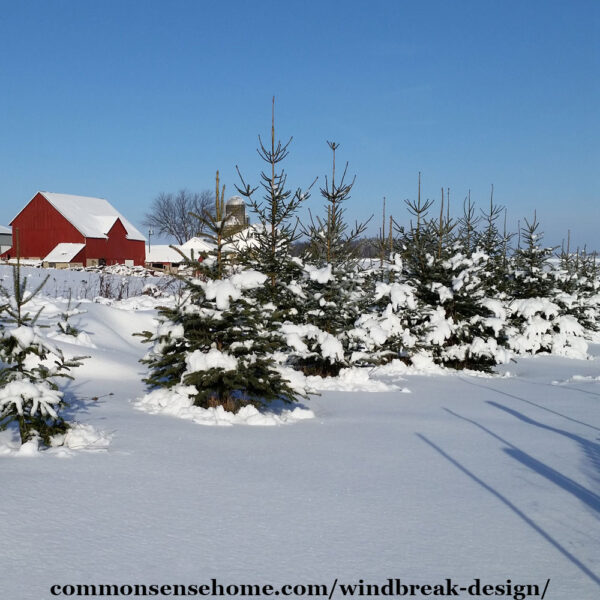
How to Find the Prevailing Wind
Start by determining prevailing winds. Here are a couple of tools to help identify prevailing winds for your location:
The “wind rose” graph below shows prevailing winds 1980 to Sept 2022 for Green Bay area. This graph indicates we should have a west tree line that extends south on the property. The prevailing winds are from the west and southwest.
Because we live in a northern climate, we’re less concerned about the southwest winds, which are usually mild. Our cold and nasty weather comes out of the west and north, so that’s the direction where we chose to plant trees first.
If you’re new to an area and don’t know where the harsh winds come from, try asking a neighbor for advice.
Windbreak Design – Height and Density
The two primary things that impact the effectiveness are: (1) Height of the windbreak and (2) Density of the windbreak.
As noted in the Windbreak Benefits article, windbreaks create a protected area stretching 10 to 30+ times the windbreak height downwind. This means that a 30 foot tall windbreak will provide some degree of protection for 300 feet to 900 feet downwind.
Density refers to how closely the trees and shrubs are planted. There are four levels of windbreaks, low density, medium density, high density and solid.

Low Density Windbreaks (25% to 35% dense)
These are used to disrupt the wind and spread out heavy snow loads. This density is quite open and doesn’t do a great job of reducing topsoil loss.
Uses: This density is used for farm field windbreaks. A tight “closed” evergreen tree line results in snow drop immediately downwind of the tree line. A more open tree line results in snow dropping over a wider area downwind of the windbreak.
This density somewhat reduces topsoil loss and increases moisture levels.
Results: A low density windbreak reduces the windspeed 50% immediately behind the windbreak. A 50ft windbreak tree line results in a protected area of 500ft.
For example, a 20mph wind would drop to 10mph within 250ft behind the windbreak. The windspeed would increase back to 20mph at roughly 30x the height of the windbreak or 1500ft if the tree line is 50ft tall.
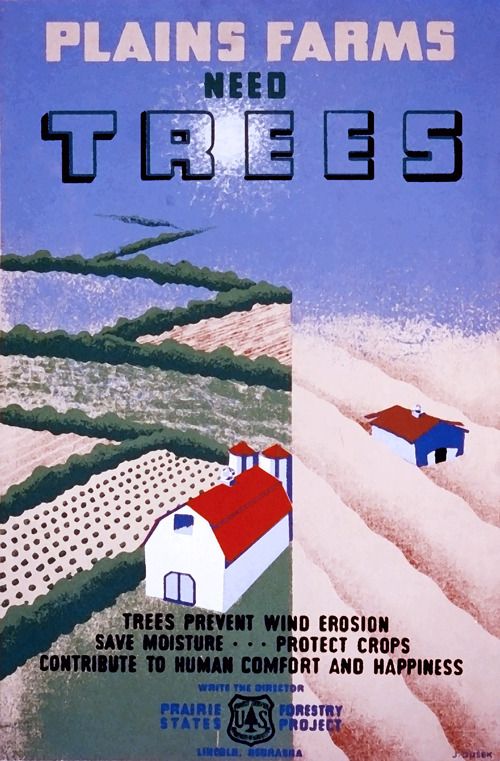
Medium Density Windbreaks (40% to 60% dense)
These will drop snow close to the downwind side of the windbreak. The higher the density of the planting, the higher the snow drop close to the trees.
Uses: Good to slow windspeeds, best windbreak design for farm fields and crops. These offer a moderate level of wind protection for the home and yard. If moisture levels are high, this density is a better choice for yard protection because it allows more airflow, reducing mildew issues.
Results: A medium density windbreak reduces the windspeed 70% immediately behind the windbreak. A 50ft windbreak tree line results in a protected area of 500ft.
For example, a 20mph wind would drop to about 6mph 250ft behind the windbreak. The windspeed would increase back to 20mph at roughly 30x the height of the windbreak or 1500ft if the tree line is 50ft tall.
High Density Windbreaks (60% to 80% dense)
These include very dense multi-row evergreen tree lines, buildings and solid fences. They provide significant reduction in wind to a distance of roughly 10 to 15 times the windbreak height.
Uses: Good for home protection, reducing heat loss and protecting a home from high winds. Also good to reduce wind chill for humans and animals. Not good for fields, can result in down drafts and heavy turbulence.
Results: A high density windbreak reduces the windspeed 75% immediately behind the windbreak. A 50ft windbreak tree line results in a protected area of 500ft.
For example, a 20mph wind would drop to about 5mph 250ft behind the windbreak. The windspeed would increase back to 20mph at roughly 30x the height of the windbreak or 1500ft if the tree line is 50ft tall.
Note: If a windbreak is extremely dense and wide, over time there may be issues with center die off due to shading. More plants does not always equal better performance.
Would you like to save this?
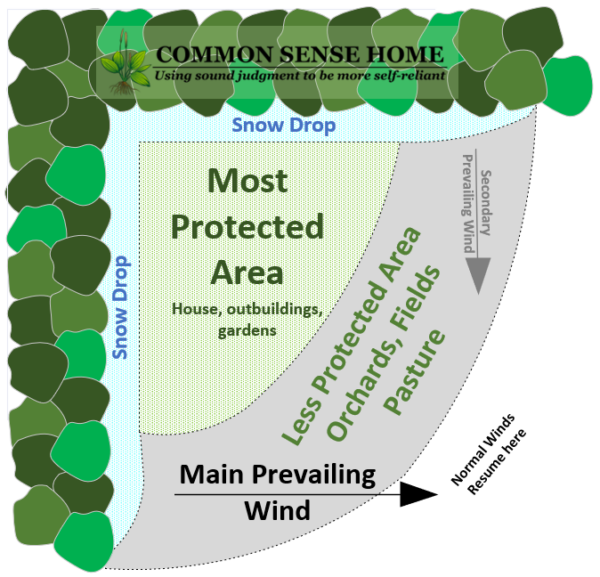
Species Selection in Windbreak Design
Select trees for your hardiness zone, soil types, moisture levels, and local microclimate. Adjust choices if there is a high risk of local tree/plant diseases.
For the southwest your goals are probably moisture, shade, and erosion control. For the Midwest, we often need snow/moisture management, erosion control, and crop protection.
Near an ocean you need salt hardy plants. In dry areas, you will need drought tolerant trees, swampy areas will need wet tolerant. Strongly acidic or strongly alkaline soils need different tree species.
In northern and mid-west areas with snow, opt for a medium to dense windbreak made of 2 to 6 rows of trees with evergreens as the highest rows. Medium Density with a mix of trees and shrubs works for fields and larger areas, and High Density is best for areas near a home and/or animals.
In the southwest in dry areas, low or moderate density is best, with 4 to 8 rows of deciduous trees and shrubs.
The simplest design is just a single row of tall trees. The best trees for a single row are tall dense evergreen trees, such as white spruce or Douglas fir (Colorado).
Tall deciduous trees such as oak, maple, ginkgo, and tulip reduce wind speeds, but not as much as dense evergreen trees. A mix of deciduous trees and shrubs can work for field crop windbreaks.
If you have enough open area, multiple rows of mixed trees offers better snow protection. On the windward side start with lower shrubs and then mid sized deciduous trees, and then taller evergreens.
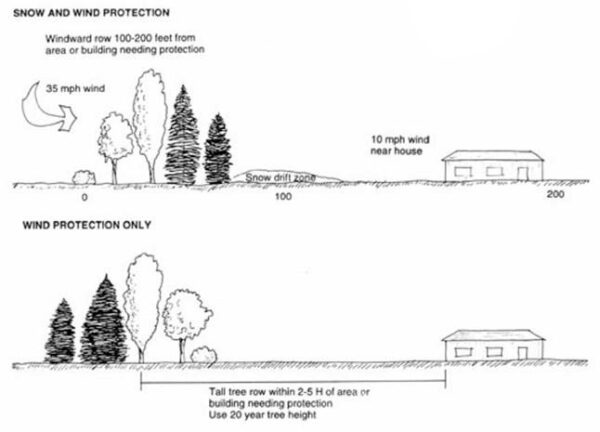
Tree Incompatibility
Sometimes what you don’t include is also important in windbreak design. Remember, trees create a microbiome that impacts surrounding plants. They might also host diseases, such as cedar apple rust, which spreads from cedars to apple trees.
Evergreen turns soil somewhat to very acidic, but most fruit trees (apples, pears, plums, etc.) will tolerate being near evergreens. However, most fruit trees will not tolerate black walnut.
All species in the walnut family produce a chemical compound called “juglone”. Black walnuts have the highest concentration, and this compound can be found in the soil 50 to 60 feet from the tree. Do not plant a vegetable garden near black walnut trees, as the juglone will impair garden growth.
Some trees are tolerant of black walnut, such as: eastern redbud, butternut, pawpaw, shagbark hickory, black locust, catalpa, hackberry, many varieties of maples, Canadian hemlock, English walnut, poplar, and red cedar.
Mixing it up
We recommend a variety of trees in the windbreak. Having all the same species of evergreen trees can result in all of them being attacked by a single pest or disease. A mix of zone compatible trees and shrubs is your best bet.
Consider fruiting trees and bushes as part of the windward side or tail end of the downwind (or leeward) side of the windbreak fence. Another idea is a leading windward rose hedgerow providing beauty and wildlife habitat. (Roses and rose hips are also useful for people food and medicine, too.)
Flowering trees and shrubs create additional habitat for honey bees, native bees, and other beneficial insects.

Our Windbreak Design
Our strongest winds come out of the west, and winter storms sometimes drop in from the north. We did a dense staggered windbreak double row of mixed species evergreens. The evergreen trees are staggered every 8 to 10 feet in two rows, running north to south. There’s a second shelterbelt running east to west at the north edge of the property.
We used a mix of conifer trees in our windbreak, including white spruce (50-80ft), blue spruce (50-75ft) and balsam (45-75ft). The old fence line west of our plantings is a mix of shrubs and vines that also acts as part of our shelterbelt.
The video below shows the aftermath of a winter storm with moderate snow and high winds. Closer to the house, the raspberry and blackberry patches also catch and drop more snow, creating deep drifts.
The results are impressive and the trees are not even mature yet.
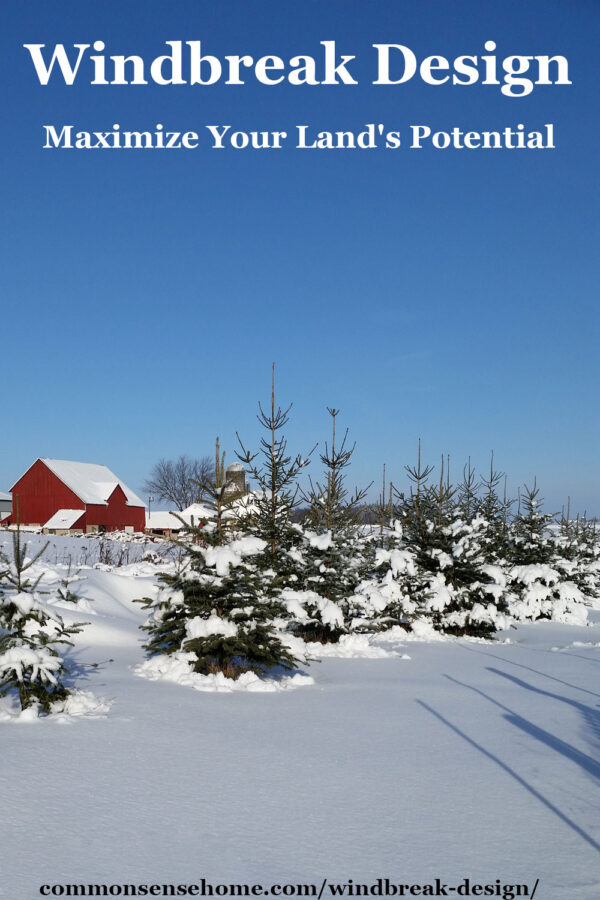
Related Articles
How to Put Up a Snow Fence (With Photos and Video)
Plant Hardiness Zones and Microclimates
Homestead Permaculture Project

